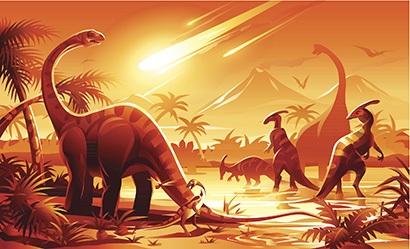Campus News
In death of dinosaurs, it was all about the asteroid — not volcanoes
Volcanic activity did not play a direct role in the mass extinction event that killed the dinosaurs, according to an international team of researchers.

Detailed illustration of a prehistoric scene showing a meteor impact causing dinosaur extinction. EPS 10, image contains transparencies. Fully editable and labeled in layers. Related images: [url=http://www.istockphoto.com/stock-illustration-19825230-dinosaurs.php][img]http://i.istockimg.com/file_thumbview_approve/19825230/1/stock-illustration-19825230-dinosaurs.jpg[/img][/url] [url=stock-illustration-22791249-mammoth-hunters.php][img]http://i.istockimg.com/file_thumbview_approve/22791249/1/stock-illustration-22791249-mammoth-hunters.jpg[/img][/url] [url=http://www.istockphoto.com/stock-illustration-18826364-dragon-scroll.php][img]http://i.istockimg.com/file_thumbview_approve/18826364/1/stock-illustration-18826364-dragon-scroll.jpg[/img][/url] [url=http://www.istockphoto.com/file_closeup.php?id=16988758] [img]http://www.istockphoto.com/file_thumbview_approve/16988758/1/istockphoto_16988758-sitting-green-dragon.jpg[/img][/url] [url=http://www.istockphoto.com/file_closeup.php?id=16885725][img]http://www.istockphoto.com/file_thumbview_approve/16885725/1/istockphoto_16885725-dragon-barbecue.jpg[/img][/url] [url=/file_closeup.php?id=16885698] [img]http://www.istockphoto.com/file_thumbview_approve/16885698/1/istockphoto_16885698-flying-red-dragon.jpg[/img][/url] [url=http://www.istockphoto.com/search/lightbox/11964366#194dde71][IMG]http://dl.dropbox.com/u/77668653/kbeis_animals-banner-1.jpg[/IMG][/url] [url=http://www.istockphoto.com/search/lightbox/10846611#16f02e28][IMG]http://dl.dropbox.com/u/77668653/kbeis_portfolio-banner-1.jpg[/IMG][/url]
Volcanic activity did not play a direct role in the mass extinction event that killed the dinosaurs, according to an international team of researchers. It was all about the asteroid impact.
In a break from a number of other recent studies, the researchers argue that environmental impacts from massive volcanic eruptions in India in the region known as the Deccan Traps happened well before the Cretaceous-Paleogene extinction event 66 million years ago and therefore did not contribute to the mass extinction.
“The bottom line is that the meteorite impact was the primary cause of the extinction event. With high-fidelity records, we can now resolve the relative contributions of volcanic carbon dioxide emissions to the changes in climate through the event, and it’s clear the effects were more or less over by the time of the event,” said coauthor James Zachos, professor of Earth and planetary sciences at UC Santa Cruz.
The new study, led by Yale geologist Pincelli Hull, was published January 16 in Science.
Most scientists acknowledge that the mass extinction event, also known as K-Pg, occurred after an asteroid slammed into Earth. Some researchers also have focused on the role of volcanoes in K-Pg due to indications that volcanic activity happened around the same time.
“Volcanoes can drive mass extinctions because they release lots of gases, like sulfur dioxide and carbon dioxide, that can alter the climate and acidify the world,” said Hull, lead author of the new study. “But recent work has focused on the timing of lava eruption rather than gas release.”
To pinpoint the timing of volcanic gas emission, Hull and her colleagues compared global temperature change and the carbon isotopes from marine fossils with models of the climatic effect of carbon dioxide release. Zachos was involved in the design and implementation of two of the ocean drilling expeditions that recovered the sediment cores used in the study to constrain the tempo and magnitude of the climatic changes.
The researchers concluded that most of the gas release happened well before the asteroid impact, and that the asteroid was the sole driver of extinction.
“Volcanic activity in the late Cretaceous caused a gradual global warming event of about two degrees, but not mass extinction,” said former Yale researcher Michael Henehan, who compiled the temperature records for the study. “A number of species moved toward the North and South poles but moved back well before the asteroid impact.”
Added Hull, “A lot of people have speculated that volcanoes mattered to K-Pg, and we’re saying, ‘No, they didn’t.’”
Recent work on the Deccan Traps, in India, has also pointed to massive eruptions in the immediate aftermath of the K-Pg mass extinction. These results have puzzled scientists because there is no warming event to match. The new study suggests an answer to this puzzle, as well.
“The K-Pg extinction was a mass extinction and this profoundly altered the global carbon cycle,” said Yale postdoctoral associate Donald Penman, the study’s modeler, who earned his Ph.D. at UCSC in 2016. “Our results show that these changes would allow the ocean to absorb an enormous amount of carbon dioxide on long time scales, perhaps hiding the warming effects of volcanism in the aftermath of the event.”
German researcher André Bornemann was co-lead author of the study. The coauthors include researchers from institutions in Germany, the United Kingdom, France, Spain, Japan, Denmark, and the United States. The International Ocean Discovery Program, the National Science Foundation, and Yale University helped fund the research.